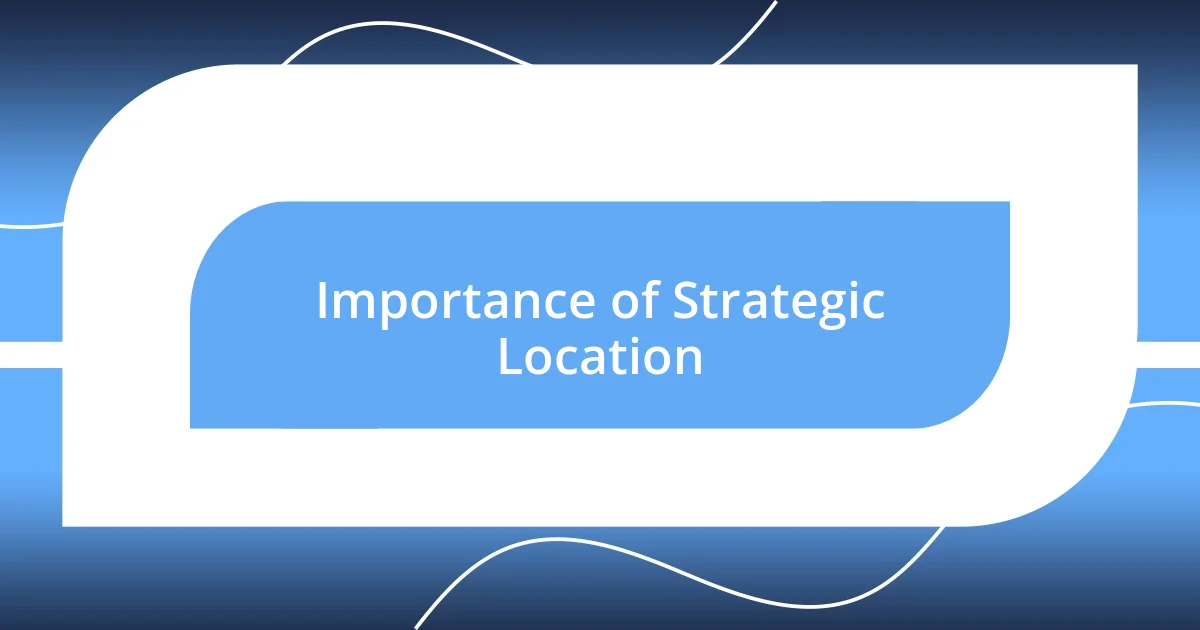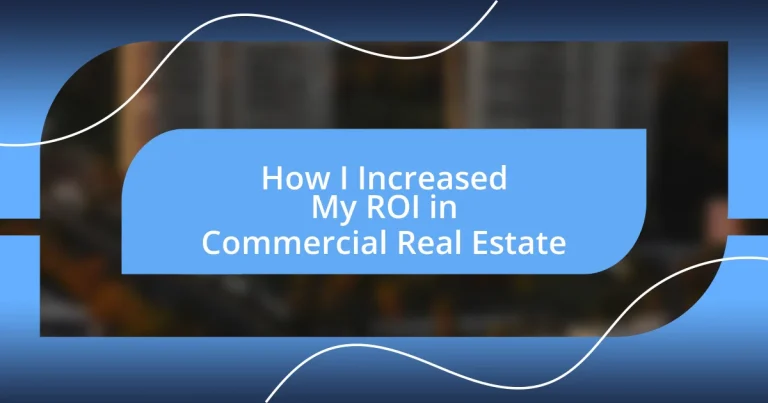Key takeaways:
- Understanding and calculating ROI involves assessing various factors such as purchase price, rental income, maintenance costs, and property appreciation, with an emphasis on patience and strategic management.
- Strategic location is crucial for investment success; properties near transportation and amenities yield higher returns, highlighting the importance of market accessibility and neighborhood trends.
- Effective marketing and regular performance analysis enhance investment outcomes, with digital strategies and storytelling resonating with potential tenants while data-driven insights guide better decision-making.

Understanding ROI in Real Estate
To me, understanding Return on Investment (ROI) in real estate isn’t just a number; it’s a reflection of the journey I’ve taken in the market. I remember my first property purchase vividly—I was excited but also nervous. I kept asking myself, “How do I know if this is a good investment?” It turns out, analyzing ROI helped me gauge the potential of my investment by balancing the expected income against the costs, leading me to make more informed decisions.
Calculating ROI involves not only the purchase price and rental income but also factors like maintenance costs and property appreciation. One property I invested in took a while to appreciate, and I almost lost hope. But I’ve learned that the market ebbs and flows, and having patience can often yield a much higher return in the long run. This kind of insight, combined with subjective factors, has truly reshaped my investment strategy over the years.
It’s essential to remember that your ROI is influenced by both market conditions and your own management decisions. I often reflect on past properties I’ve flipped; when focusing on quality renovations, my ROI soared compared to projects where I cut corners. Isn’t it fascinating how a little attention to detail can significantly impact returns? Understanding these nuances has been key to increasing my ROI in commercial real estate.

Importance of Strategic Location
Strategic location is perhaps the most significant factor in determining the success of a commercial real estate investment. I once invested in a property in a lesser-known suburb, thinking it was a hidden gem. Although the property itself was lovely, its distance from major business hubs turned out to be a hurdle for attracting tenants. It became clear to me that a great location can elevate a property’s appeal and consequently, its ROI.
When I shifted my focus to properties near transit hubs and emerging neighborhoods, the difference was astounding. One property near a new metro line experienced a dramatic increase in rental rates within months. This taught me that access to transportation and amenities wasn’t just a bonus; it was a necessity. Each time I consider a new investment, I evaluate its proximity to parks, schools, and shopping centers, knowing these factors can make or break a deal.
Ultimately, I have come to view location as the bedrock of successful investments. I remember a colleague who invested in a high-footfall area and couldn’t believe how quickly his property was leased. In contrast, my previous endeavor reminded me that the allure of a property is directly tied to its surroundings. This experience has instilled in me a renewed dedication to prioritizing location above all else in my future investments.
| Location Factor | Impact on ROI |
|---|---|
| Proximity to Transport | High demand drives up rental prices. |
| Surrounding Amenities | Attracts more tenants and enhances property value. |
| Neighborhood Trends | Emerging areas can yield better returns over time. |

Value of Market Research
Market research is an invaluable tool in my journey within commercial real estate. I recall a time when I hesitated to invest in a specific market due to lackluster rental rates. However, diligent research revealed upcoming developments that would transform the area. This moment taught me that looking beyond surface-level data often unveils lucrative opportunities waiting to be tapped.
Here are a few critical aspects of market research that I constantly keep in mind:
- Local Economic Trends: Understand employment rates and major industries to gauge demand for rental properties.
- Comparable Property Analysis: Examining similar properties helps you pinpoint pricing strategies and expected rental income.
- Future Development Plans: Keeping an eye on proposed developments allows for a better forecast of property appreciation and potential ROI.
I’ve learned that the depth of market research can often mean the difference between a lackluster investment and a high-performing one. When I chose to invest in a previously overlooked city, I immersed myself in demographic studies and local business growth reports. This knowledge not only validated my decision but also empowered me when negotiating prices. The confidence that comes from solid market research is something I now view as a cornerstone for sustainable profits in my investments.

Techniques for Cost Reduction
I’ve always believed in keeping an eye on operational efficiencies as a way to cut costs. Once, after realizing my utility bills were climbing, I decided to invest in energy-efficient upgrades for one of my properties. The shift not only reduced my expenses significantly but also attracted environmentally conscious tenants willing to pay a premium for lower utility costs. Have you ever considered how small changes can lead to bigger savings?
Another technique I’ve found invaluable is negotiating favorable contract terms with service providers. In one of my earlier ventures, I was paying top dollar for maintenance services, which ate into my profits. By simply reaching out and discussing long-term agreements, I secured lower rates while ensuring that my properties continued to receive the care they needed. This taught me the power of negotiation; sometimes, a proactive approach can unlock valuable savings.
I also make it a habit to review property management fees regularly. In one instance, I discovered that switching to a more regional management firm resulted in a 15% decrease in fees without compromising service quality. It’s crucial to stay informed about what different firms offer. Knowing the landscape allows me to make better financial decisions and ensures I get the best bang for my buck. I often remind myself that reducing expenses doesn’t have to mean cutting corners; it can lead to smarter, more sustainable investment practices.

Enhancing Property Management Practices
When it comes to enhancing property management practices, I quickly realized the importance of fostering strong relationships with tenants. I remember a time when a simple conversation with a tenant about their concerns led to minor renovations that improved their living experience and significantly reduced turnover. Have you ever thought about how little gestures, like responding promptly to maintenance requests, can build a sense of community? Investing in these relationships not only boosts tenant satisfaction but also increases the likelihood of longer leases, which directly impacts my ROI.
Implementing technology in property management has transformed my approach dramatically. I always felt overwhelmed by paperwork, but adopting a property management software streamlined everything from rent collection to maintenance tracking. I now have more time to focus on enhancing tenant relations rather than drowning in administrative tasks. Isn’t it amazing how technology can turn chaos into order? The immediate improvement I noticed in operational efficiency was a game changer, as it allowed me to proactively address issues before they escalated.
Additionally, refining my communication strategies with both tenants and team members has made a world of difference. I used to rely heavily on email updates, but once I switched to more interactive platforms like chat groups, I saw a boost in engagement. This shift encouraged more open dialogues and quicker resolutions. Have you faced challenges in communication with your team or tenants? By being approachable and transparent, I’ve not only minimized misunderstandings but also created a culture that values feedback, leading to more informed decisions and a happier community.

Effective Marketing Strategies
Effective Marketing Strategies
One of the most significant shifts I made in my marketing strategy was to embrace digital platforms. Initially, I relied heavily on traditional print advertising, but after feeling the pressure of a competitive market, I decided to invest time in social media marketing. Have you ever noticed how a single post can generate waves of interest? I remember one particular listing that went viral on several platforms, ultimately leading to multiple offers in just a few days. It was a reminder of how the digital world can amplify reach and engagement far beyond what I had previously imagined.
Another valuable strategy I adopted was hosting open house events tailored to target audiences. I once organized a casual weekend brunch at one of my properties, inviting local businesses and community members to explore the space. The warm atmosphere not only showcased the property but also allowed me to build relationships with potential tenants. It’s incredible how simply creating space for conversation can drive interest and engagement. Have you thought about using your property as a community hub? This approach turned out to be an effective way to foster a sense of belonging, which ultimately led to faster leases and happier tenants.
I also emphasized the importance of storytelling in my listings. Instead of just listing features, I began to craft narratives that highlighted the unique lifestyle each property offered. For instance, when I marketed a loft in a vibrant neighborhood, I shared not just the amenities but also stories about local artists and events that thrived nearby. Don’t you think potential tenants would be drawn to a place that feels alive? This storytelling approach resonated deeply with prospective tenants and helped them envision their lives within those walls, ultimately increasing my occupancy rates and solidifying my brand in the marketplace.

Measuring and Analyzing Results
Measuring and analyzing results is critical to understanding the effectiveness of my strategies in commercial real estate. When I began tracking key performance indicators (KPIs), I had a more visual representation of my progress. I still vividly recall the moment I saw a significant drop in vacancy rates on my dashboard. It felt like a win—like I could finally quantify the impact of my efforts. Have you ever experienced that thrill of seeing numbers align with your expectations?
One useful tool I integrated into my analysis was regular performance reviews. I remember sitting down at the end of each quarter to compare numbers, like rental income and maintenance costs, alongside tenant feedback. These reviews uncovered patterns that I never would have noticed otherwise. For example, I discovered that certain amenities consistently led to shorter marketing times. Isn’t it fascinating how data can tell a story all its own? This process not only helped me pivot my strategies but also reinforced the importance of staying informed.
Constructing detailed reports after major changes or renovations also became a key practice. One time, after renovating a key property, I documented everything: costs, tenant reactions, and increases in interest. I could literally see the return on investment not just in financial terms but also through tenant satisfaction ratings. This informed approach helped instill confidence within my team when pitching new ideas. Have you considered documenting outcomes to gauge success in your ventures? It has turned into a cornerstone of my decision-making process, and I can confidently say it has shaped my path to increasing ROI.














